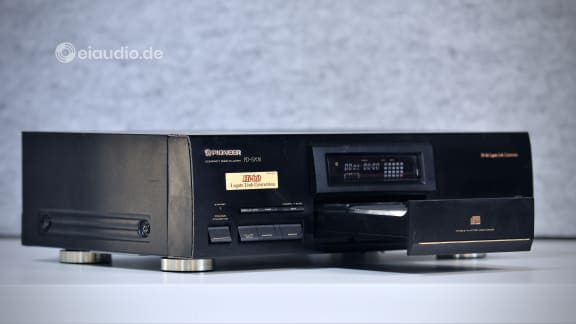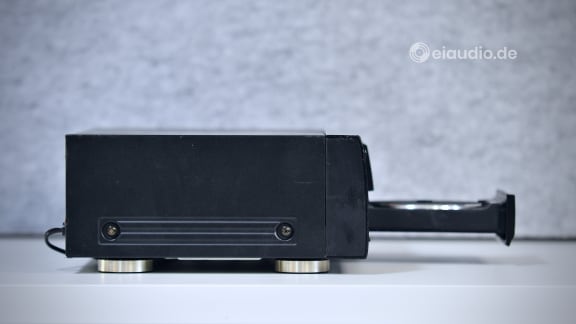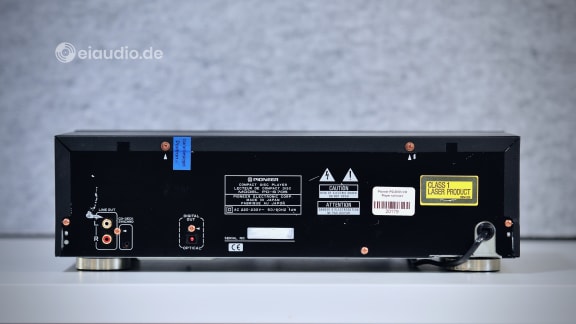Pioneer PD-S705
Published: 02/09/2024
Manufacturing date: 1996
Author: Karsten Hein
Category: Gear & Review
Tag(s): CD-Players
Pioneer’s PD-S 705 CD player came out in 1996 and was the top-of-the-range model of the new x05 series. Just above it, was the popular PD-S 904, which had been released in the previous year. Arriving shortly after its famous siblings, the PD-S 705 bridged the gap between them and was an attractive choice for consumers seeking the technology of the PD-S 904 at a more affordable price. The main drawback of the PD-S 705 was that, like the PD-S 604 and the other entry-level players, it lacked a coaxial digital output for proper connection to an external digital-to-analogue converter (DAC) or to the digital input of a preamplifier or amplifier. For most people of the time, however, this compromise in versatility would not have mattered much, because CD players were predominantly the only digital HiFi equipment in their home.
In April 2024 I wrote an article about the smaller PD-S 604, in which I highlighted the benefits of Pioneer's Stable Platter mechanism for critical and audiophile listening. The platter is an integral part of the player's drive unit and supports the disc in its full dimension from underneath, rather than just gripping it in the middle. This greatly reduces disc wobble and allows the source material to be read with great accuracy. Since the purpose of any hi-fi system is to amplify and attenuate this initial signal, its integrity is of paramount importance. The PD-S 705 uses the same technology, but with a more advanced drive unit (PEA1291 instead of PEA1179). The improvements over the PD-S 604 are noticeable in the smoother opening and closing of the mechanism, as well as an even smoother disc rotation, resulting in ultra-fast initialisation of the disc when the tray is closed.
My article then went on to discuss the benefits of Legato Link, which does not abruptly cut off the high frequency content of the CD, as most CD players do, but instead uses spline interpolation to create a softer and more natural or 'analogue' sounding top end. Whereas on the PD-S 604 this technology could sometimes emphasise treble content in an undesirable way - as if to create artefacts on some recordings - the effect was much less pronounced on the PD-S 705, if it was detectable at all. I am thinking of a 2007 Sony & BMG 'Kuschel Jazz' CD, on which some songs produced an ultra-wide and three-dimensional soundstage at the cost of occasional inaccuracies in the top end. Jazzy interpretations such as Joel Harrison & Norah Jones' 'I Walk the Line' may also sound a little sharp on the PD-S 705, but I could not detect any digital errors, anomalies, or artefacts.
Although it uses the same digital-to-analogue converter (PD2029A), the PD-S 705 offers a +2db improved signal-to-noise ratio of 110dB. To achieve this, the PD-S 705 sacrifices some of the features found on the PD-S 604. For example, there is no variable line output, which would allow the output signal to be attenuated towards the amplifier. There is no headphone socket on the front panel, and consequently no motorised volume control. Whereas the 1980s still saw elaborate control panels with lots of functions and buttons, the late 1990s brought about a return to the essentials, with a simpler design philosophy focusing only on sound. The latter is probably the reason why the PD-S 705 has an off switch for the LCD display. Personally, I was delighted to find this feature on board, as I know that most audio equipment only reaches its full sonic potential when the display is switched off. Stray currents from the display can all too easily introduce audible noise into the music signal.
On the PD-S 705, the audio output paths are switchable, allowing the user to activate and deactivate both the digital optical output and the analogue output separately, depending on the application, in order to reduce interference. The PD-S 705 reduces Total Harmonic Distortion from an already low 0.0028% to 0.0026%, which is significant when combined with the improved signal-to-noise ratio. Next to being 1.5cm taller, the PD-S 705 is also 300 grams heavier than the PD-S 604, which gives it a more stable base and compensates for the heavier disc tray. On the other hand, the cabinet is still made from the same cheap bent sheet metal found on most hi-fi equipment to this day.
With the PD-S 604, I learned that adding some anti-resonant foil to the inside of the cabinet helped to make the sound more assured. As I had bought my PD-S 705 in refurbished condition from a professional German up-cycler, complete with a limited one-year warranty, I did not dare break the paper seal. I like the concept of repairing and reselling older electronics, giving them a second life. With this in mind, I was delighted to find Positron-e GmbH of 85368 Moosburg in Germany, who sell their refurbished and approved products on eBay. For the time being, however, the warranty means that I will have to live with the standard metal cover for a while, and I cannot show you any photos of the inside of the player just yet. This, and the slightly higher price, were small concessions to having the security of a professional service centre at my disposal, just in case there were any technical problems down the line.
In general, Pioneer's PD-S players are well-built audio machines that will give you many years of trouble-free service. In my experience, they benefit from interconnects that are quick and revealing to keep the player from sounding dull. I use unshielded silver solid core cables in twisted pairs. These cables work very well and allow the Pioneer to integrate seamlessly with high-end amplifiers such as the Symphonic Line RG9 MK3 and the newer Symphonic Line RG9 MK5. Compared to similarly priced NAD players, the Pioneer's soundstage was a little less sharp, instruments were not quite as three-dimensional, but speed and rhythm were more engaging and seemed more lifelike. The PD-S 705 may not be the most spectacular player, but its faithful reproduction of musical events and pleasant, analogue-sounding top end make it a great all-rounder and perfectly suitable for audiophile listening sessions.
< Pioneer PD-S 604 | Symphonic Line RG9 MK3 >
Specifications:
- Type: Stable Patter mechanism CD player
- Power requirements: AC 220 - 240 V, 50/60 Hz
- Digital converter: PD2029A
- CD Mechanism: PEA1291
- Frequency response: 2 Hz - 20,000 Hz
- Signal to noise ratio: > 110 dB
- Dynamic range: > 96 dB
- Total harmonic distortion: < 0.0026%
- Line output voltage (max.): 2 V
- Wow and flutter: < 0.001% (below measurable)
- Number of channels: 2-channel (stereo)
- Variable line output (stereo): not included
- Fixed line output (stereo): 1x cinch/RCA
- Digital output (stereo): 1x optical only
- Accessory jack: CD-Deck synchro to tape
- Headphone jack: not included
- Accessories: remote control unit
- Display options: on / off / time / program
- Remote batteries: 2x AAA
- Power consumption: 14 Watts
- Operating temperature: +5 to + 35 C
- Dimensions: (W) 420mm, (D) 283mm, (H) 125mm
- Product weight: 4.2 kg
- Country of Manufacture: Japan
- Year(s): 1996 - 1998





